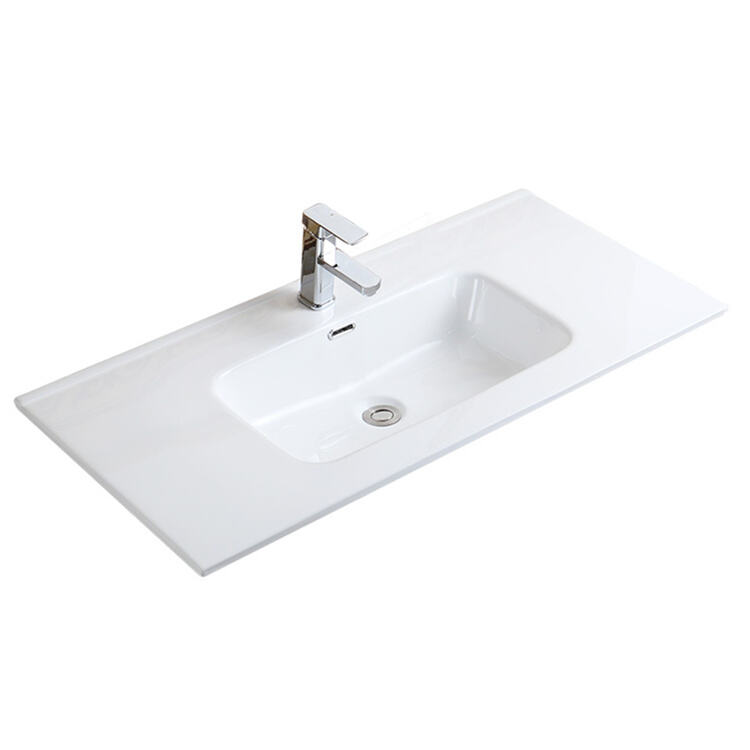What Is a Cabinet Basin and How Is It Used?
A cabinet basin is a practical and popular bathroom fixture that combines a sink (basin) with a storage cabinet underneath. Unlike wall-mounted basins or countertop basins, which need separate support or storage, a cabinet basin integrates both functions into one unit. This makes it a space-saving, stylish choice for bathrooms of all sizes, from small apartments to large family homes. Let’s explore what a cabinet basin is, its key features, and how it’s used in daily life.
1. What Is a Cabinet Basin?
A cabinet basin is a single unit consisting of two main parts:
- The basin: The sink part, usually made of materials like porcelain, ceramic, resin, or stone. It comes in shapes like round, square, oval, or rectangular, and may have one or two faucet holes.
- The cabinet: A storage unit directly under the basin, with doors, drawers, or open shelves. Cabinets are often made of wood, MDF (medium-density fiberboard), or waterproof materials (to handle bathroom moisture). They hide pipes and provide space for toiletries, cleaning supplies, or towels.
This combination means the cabinet basin serves two purposes: a functional sink for washing hands, brushing teeth, or washing small items, and built-in storage to keep the bathroom tidy.
2. Key Features of Cabinet Basins
Cabinet basins are designed to be both useful and flexible, with features that make them suitable for different bathroom needs:
- Space efficiency: By merging the basin and cabinet, they save floor space. This is especially valuable in small bathrooms, where every inch counts. The cabinet keeps items hidden, reducing clutter on the countertop.
- Moisture resistance: Good cabinet basins use waterproof materials for the cabinet (like treated wood or PVC) and a basin with a smooth, non-porous surface (porcelain or ceramic). This prevents water damage from splashes or humidity.
- Variety of styles: They come in many designs to match bathroom decor. Modern cabinet basins may have sleek, handle-less cabinets and square basins, while traditional ones might have curved basins and wooden cabinets with detailed handles.
- Easy installation: Most cabinet basins are pre-assembled or come with simple instructions. They can be mounted to the wall or placed on the floor, depending on the design. Floor-standing models are stable and easy to install, while wall-mounted ones save even more space.
3. How Cabinet Basins Are Used in Daily Life
A cabinet basin is a workhorse in the bathroom, used for daily tasks while keeping essentials organized:
- Basic hygiene routines: It’s the go-to spot for washing hands, brushing teeth, or rinsing face cloths. The basin’s depth (usually 15–20 cm) prevents splashing, keeping the cabinet and floor dry.
- Storage for essentials: The cabinet underneath holds items like soap, shampoo, toothbrushes, and cleaning products. Drawers are great for small items (razors, cotton pads), while doors hide larger bottles or cleaning tools. Open shelves can display decorative items (like candles or small plants) while keeping frequently used items handy.
- Hiding unsightly pipes: The cabinet covers the plumbing pipes under the basin, making the bathroom look neater. This is a big advantage over pedestal basins, where pipes are visible.
- Washing small items: The basin’s size is perfect for rinsing small items like washcloths, toothbrushes, or even children’s toys. Its smooth surface makes cleaning easy—just wipe with a damp cloth.
For families, shared bathrooms, or anyone wanting a tidy space, the cabinet basin’s mix of function and storage is invaluable.
4. Choosing the Right Cabinet Basin for Your Bathroom
To pick the best cabinet basin, consider these factors:
- Size: Measure your bathroom space. A small bathroom (1–2 m²) needs a compact cabinet basin (60–80 cm wide), while larger bathrooms can handle wider models (90–120 cm) with more storage.
- Style: Match the cabinet basin to your bathroom’s decor. A modern bathroom with glass shower doors and chrome fixtures pairs well with a white or gray cabinet basin. A rustic bathroom with wooden shelves might suit a wooden cabinet with a ceramic basin.
- Material: The basin should be durable and easy to clean—porcelain and ceramic are top choices. For the cabinet, waterproof materials (like MDF with a moisture-resistant coating) are best for longevity.
- Faucet compatibility: Ensure the basin has holes for your chosen faucet (single-handle, double-handle, or wall-mounted). Most basins come with pre-drilled holes, but some can be customized.
FAQ
Can a cabinet basin be used in a small bathroom?
Yes, it’s ideal. Compact models (60–70 cm wide) fit in small spaces, and wall-mounted designs save floor space. The storage keeps clutter hidden, making the bathroom feel larger.
How do I clean a cabinet basin?
Wipe the basin with mild soap and water—avoid harsh chemicals that can damage the surface. For the cabinet, dust regularly and wipe with a damp cloth. If there’s a spill, dry it quickly to prevent water damage.
Are cabinet basins more expensive than other basins?
They can be, because they include both a basin and a cabinet. But they’re cost-effective in the long run, as you don’t need to buy a separate cabinet or shelf for storage.
Can I replace just the basin or the cabinet if one gets damaged?
In most cases, yes. Many manufacturers sell replacement basins or cabinet parts. Check if the model you choose has replaceable components before buying.
Do cabinet basins come with mirrors?
Some sets include a matching mirror above the basin, but most are sold separately. This lets you choose a mirror that fits your style—from simple rectangular ones to framed or backlit designs.
